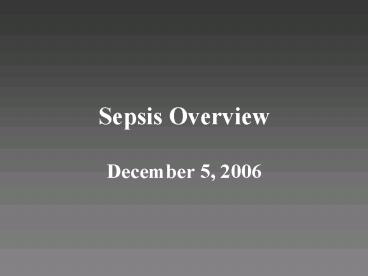Sepsis Overview - PowerPoint PPT Presentation
1 / 26
Title:
Sepsis Overview
Description:
Mild dysfunction to frank organ failure. Changes in the function of every organ system mediated by the ... beta 2 adrenergic and dopaminergic effects, NO alpha ... – PowerPoint PPT presentation
Number of Views:100
Avg rating:3.0/5.0
Title: Sepsis Overview
1
Sepsis Overview
- December 5, 2006
2
Sepsis
- Continuum of clinical pathophysiology and
severity - Process rather than an event
- Mild dysfunction to frank organ failure
- Changes in the function of every organ system
mediated by the host immune system.
3
Sepsis
- Systemic Inflammatory Response Syndrome-ACCP/SCCM
Consensus - Temperature gt38C or lt36
- Heart rate gt90 bpm
- Respiratory Rategt20 or PaCO2lt32mmHg
- WBCgt12,000/µl or lt4,000/µl
4
Sepsis
- Sepsis 2 or more-
- Tachycardia gt90bpm
- Rectal tempgt38C or lt36C
- Tachypnea(gt20bpm)
- With 1 or more
- Alteration in mental status
- Hypoxemia (PaO2lt72mmHG at FiO20.21)
- Elevated plasma lactate
- Oligouria
5
Sepsis
- Severe Sepsis
- Tachycardia gt90bpm
- Rectal tempgt38C or lt36C
- Tachypnea(gt20bpm) or PaCO2lt32mmHg
- Hypotension despite fluid resuscitation
- Presence of perfusion abnormalities lactic
acidosis, oligouria, alteration in mental status
6
Sepsis
- Mediators of Sepsis
- Lipospolysaccharide (gram-negative bacteria)
- Lipoteichoic acid (gram-positive bacteria
- Peptidoglycan
- Cytokines
- IL-1 mediates systemic effects of infection
- IL-6 effects liver function
- TNF-a- potentiates the activation of neutrophils
and macrophages - IL-8 regulates neutrophil function, mediates
lung injury in sepsis
7
Sepsis
- Mediators of Sepsis
- Complement
- Nitric Oxide
- Lipid Mediators Chemotaxis, Cell activation,
Vascular Permeability - Phospholipase A2
- PAF
- Eicosanoids
8
Sepsis
- Mediators of Sepsis
- Adhesion Molecules
- Selectins
- Leukocyte Antigens
9
Sepsis
- Circulatory Manifestations
- Vasodilation
- Tachycardia
- Increased Cardiac Output
- Depressed Myocardial Function
- Increased Delivery
- Decreased Extraction
10
Sepsis
- Circulatory Manifestations
- Downregulation of catecholamine receptors
- Increased local vasodilating substances
- Nitric oxide
- Prostacyclin
- Decreased Oxygen
- Low pH
- Increased anaerobic metabolism
- Shunting
11
Sepsis
- Pulmonary Dysfunction
- Endothelial Injury
- Interstitial Edema
- Alveolar Edema
- Neutrophil entrapment
- Injury Type I pneumocyte
- Hyperplasia Type II pneumocyte
- Continued Neutrophil, monocyte, leukocyte and
platelet aggregation
12
Sepsis
- Other Organ Dysfunction
- GI
- Ileus
- Malabsorption
- Overgrowth of bacteria, Translocation
- Liver
- Renal
- CNS
13
Sepsis
- Organisms
- Lower Respiratory Tract Infections (25)
- Urinary Tract Infections (25)
- Gastrointestinal Infections (25)
- Soft Tissue Infections (15)
- Reproductive Organs (5)
14
Sepsis
- Risk Factors
- Extremes of Age (lt10 and gt70 years)
- Pre-existing Organ Dysfunction
- Immunosuppression
- Major Surgery, Trauma, Burns
- Indwelling Devices
- Prolonged Hospitalization
- Malnutrition
- Prior Antibiotic Treatment
15
Sepsis
- Principles for Management of Sepsis
- Early Recognition
- Early and Adequate Antibiotic Therapy
- Source Control
- Early Hemodynamic Resuscitation and continued
support - Drotrecogin Alpha (Apache IIgt25)
- Tight Glycemic Control
- Ventilatory Support
16
Sepsis
- Drotrecogin-alpha/Recombinant Human Activated
Protein C - Reduced levels of anti-inflammatory mediators
- Activated Protein C
- Inhibits thrombosis
- Decreases inflammation
- Promotes fibrinolysis
- Side Effect Bleeding
- PROWESS study group
- Lower mortality rate (24.7 vs. 30.8)
17
Sepsis
- Steroids???
- Older trials used high doses
- Recent trials suggest low dose, with taper and
tight glycemic control may improve outcome - Vasopressor-dependent shock
- Cosyntropin Stim Test-Relative Adrenal
Insufficiency (lt9mcg/dL)
18
Sepsis
- Experimental Therapies
- Dopexamine- beta 2 adrenergic and dopaminergic
effects, NO alpha adrenergic activity - Vasopressin- reduces inducible NO synthase,
upregulates endogenous catecholamine receptors - Phosphodiesterase Inhibitors-ionotropic agents
with vasodilating actions - Nitric Oxide Inhibitors- N-monomethyl-l-arginine
19
ARDS
- Frequent Complication in Sepsis(40)
- Adult Respiratory Distress Syndrome
- Oxygenation abnormality PaO2/FiO2 ratio less
than 200 - Bilateral opacities on CXR
- PAOP lt18mm Hg or no evidence of L atrial
hypertension
20
ARDS
- Frequent Complication in Sepsis(40)
- Adult Respiratory Distress Syndrome
- Oxygenation abnormality PaO2/FiO2 ratio less
than 200 - Bilateral opacities on CXR
- PAOP lt18mm Hg or no evidence of L atrial
hypertension - Frequency of ARDS in sepsis 18-38
- 16 patients die w/irreversible respiratory
failure
21
ARDS
- Pathophysiology
- Injury to Alveolocapillary unit
- Exudative Phase
- Endothelial injury, immune cell infiltration,
pneumocyte and endothelial injury and necrosis - Proliferative Phase
- Organization of exudate, myofibroblast
proliferation - Conversion of exudate to fibrous tissue
- Fibrotic Phase
- Remodeling of fibrosis, microcystic honeycomb
formation and traction bronchiectasis
22
ARDS
- Management
- Lung-Protective Strategy-Reduction of Barotrauma
- TV 5ml/kg
- Longer inspiratory time
- Peak Inspiratory Pressurelt35-40cmH2O
- Permissive Hypercapnea
- PEEP
23
Acute Renal Failure
- Increases Mortality in ICU 30
- Physiology
- Glomerular Filtration dependent on perfusion
pressure (MAP 60-80mmHg) - Less than 60mmHG
- Decreased flow
- Arterial dilation in pre-glomerular arterioles
(prostaglandins) - Constriction of post-glomerular arterioles
(angiotensin II)
24
Acute Renal Failure
- As Renal Perfusion Falls
- Increased reabsorption in proximal tubules
- 90 water is reabsorbed (normal is 60)
- Decreased fluid to the distal tubules
- Loss of potassium elimination
- Tubular cells dependent on aerobic respiration
- Ascending loop is most sensitive to ischemia
25
Acute Renal Failure
- Dose all drugs appropriately
- Correction of Metabolic Acidosis
- Isotonic Bicarbonate
- Cannot Correct Ongoing Hypoperfusion
- Renal Replacement Therapy
- Absolute indication
- Acidosis
- Hyperkalemia
- Uremia (relative)
26
Sepsis
- Principles for Management of Sepsis
- Early Recognition
- Early and Adequate Antibiotic Therapy
- Source Control
- Early Hemodynamic Resuscitation and continued
support - Drotrecogin Alpha (Apache IIgt25)
- Tight Glycemic Control
- Ventilatory Support































